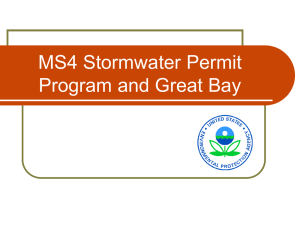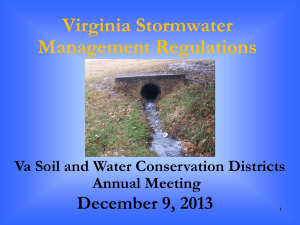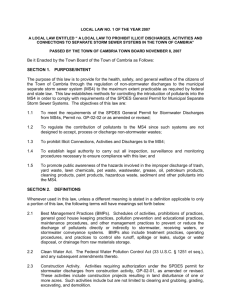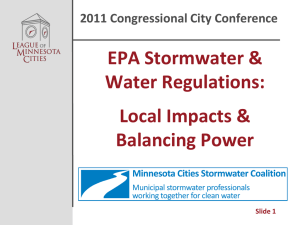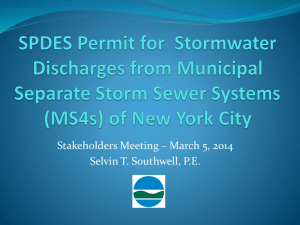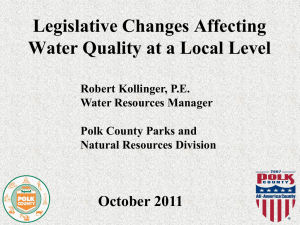Local Law No - Village of Sloatsburg
advertisement
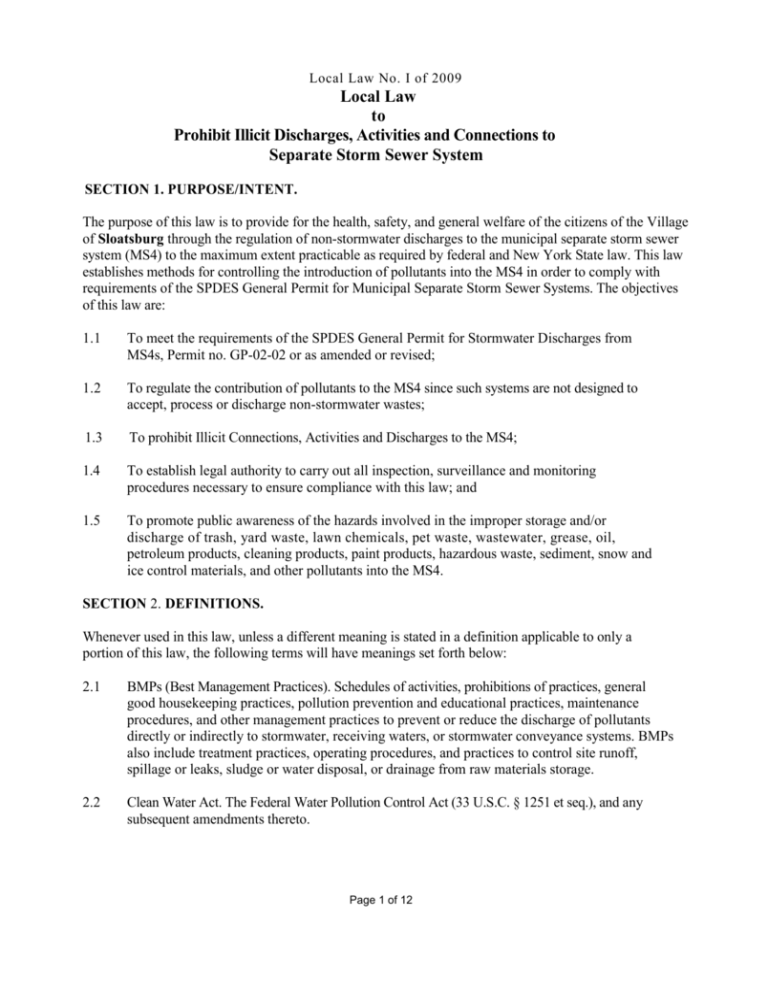
Local Law No. I of 2009 Local Law to Prohibit Illicit Discharges, Activities and Connections to Separate Storm Sewer System SECTION 1. PURPOSE/INTENT. The purpose of this law is to provide for the health, safety, and general welfare of the citizens of the Village of Sloatsburg through the regulation of non-stormwater discharges to the municipal separate storm sewer system (MS4) to the maximum extent practicable as required by federal and New York State law. This law establishes methods for controlling the introduction of pollutants into the MS4 in order to comply with requirements of the SPDES General Permit for Municipal Separate Storm Sewer Systems. The objectives of this law are: 1.1 To meet the requirements of the SPDES General Permit for Stormwater Discharges from MS4s, Permit no. GP-02-02 or as amended or revised; 1.2 To regulate the contribution of pollutants to the MS4 since such systems are not designed to accept, process or discharge non-stormwater wastes; 1.3 To prohibit Illicit Connections, Activities and Discharges to the MS4; 1.4 To establish legal authority to carry out all inspection, surveillance and monitoring procedures necessary to ensure compliance with this law; and 1.5 To promote public awareness of the hazards involved in the improper storage and/or discharge of trash, yard waste, lawn chemicals, pet waste, wastewater, grease, oil, petroleum products, cleaning products, paint products, hazardous waste, sediment, snow and ice control materials, and other pollutants into the MS4. SECTION 2. DEFINITIONS. Whenever used in this law, unless a different meaning is stated in a definition applicable to only a portion of this law, the following terms will have meanings set forth below: 2.1 BMPs (Best Management Practices). Schedules of activities, prohibitions of practices, general good housekeeping practices, pollution prevention and educational practices, maintenance procedures, and other management practices to prevent or reduce the discharge of pollutants directly or indirectly to stormwater, receiving waters, or stormwater conveyance systems. BMPs also include treatment practices, operating procedures, and practices to control site runoff, spillage or leaks, sludge or water disposal, or drainage from raw materials storage. 2.2 Clean Water Act. The Federal Water Pollution Control Act (33 U.S.C. § 1251 et seq.), and any subsequent amendments thereto. Page 1 of 12 2.3 Construction Activity. Activities requiring authorization under the SPDES permit for stormwater discharges from construction activity, GP-02-01, as amended or revised and any land disturbance requiring a municipal, New York State, or federal permit. These activities include construction projects resulting in land disturbance. Such activities include but are not limited to clearing and grubbing, grading, excavating, and demolition. 2.4 Discharger. Any Person who owns or is in control of real or personal property that discharges, directly or indirectly, any material into the MS4. 2.5 Hazardous Materials. Any material, including any substance, waste, or combination thereof, which because of its quantity, concentration, or physical, chemical, or infectious characteristics may cause, or significantly contribute to, a substantial present or potential hazard to human health, safety, property, or the environment when improperly treated, stored, transported, disposed of, or otherwise managed 2.6 Illicit Connections. Any drain or conveyance, whether on the surface or subsurface, which allows an illegal discharge to enter the MS4, including but not limited to: 2.6.1. Any conveyances which allow any Non-Stormwater Discharge including treated or untreated sewage, process wastewater, and wash water to enter the MS4 and any connections to the storm drain system from indoor drains and sinks, regardless of whether said drain or connection had been previously allowed, permitted, or approved by an authorized enforcement agency; or 2.6.2 Any drain or conveyance connected from a commercial or industrial land use to the MS4 which has not been documented in plans, maps, or equivalent records and approved by an authorized enforcement agency. 2.7 Illicit Discharge. Any direct or indirect Non-Stormwater Discharge to the MS4, except as exempted in Section 5 of this law. 2.8 Individual Sewage Treatment System. A facility including septics, cesspools and similar facilities serving one or more parcels of land or residential households, or a private, commercial or institutional facility, that treats sewage or other liquid wastes for discharge into the groundwaters of New York State, except where a permit for such a facility is required under the applicable provisions of Article 17 of the Environmental Conservation Law. 2.9 Industrial Activity. Activities requiring the SPDES permit for discharges from industrial activities except construction, GP-98-03, as amended or revised. 2.10 MS4. Mun c pal Separate Stormwater Sewer System. 2.11 Municipal Separate Stormwater Sewer System. A conveyance or system of conveyances (including roads with drainage systems, municipal streets, catch basins, curbs, gutters, ditches, man-made channels, or storm drains): Page 2 of 12 2.11.1. Owned or operated by the Village of Sloatsburg; 2.11.2 Designed or used for collecting or conveying stormwater; 2.11.3. Which is not a combined sewer; and 2.11.4. Which is not part of a Publicly Owned Treatment Works (POTW) as defined at 40CFR 122.2 2.12 Municipality. The Village of Sloatsburg. 2.13 NYS DEC. The New York State Department of Environmental Conservation. 2.14 Non-Stormwater Discharge. Any discharge to the MS4 that is not composed entirely of stormwater. This includes any Pollutants, as well as but not limited to trash, yard waste, or pet waste. 2.15 Person. Any individual, association, organization, partnership, firm, corporation or other entity owning the Property or having control of the Property. 2.16 Pollutant. Dredged spoil, filter backwash, solid waste, incinerator residue, treated or untreated sewage, garbage, sewage sludge, munitions, chemical wastes, biological materials, radioactive materials, heat, wrecked or discarded equipment, rock, sand, soil and industrial, municipal, agricultural waste and ballast discharged into water or any substance which may cause or might reasonably be expected to cause pollution of the waters of the state in contravention of the standards. 2.17 Property. Any building, lot, parcel of land, or portion of land whether improved or unimproved including adjacent sidewalks and parking strips and all chattel 2.18 SPDES (State Pollutant Discharge Elimination System) Stormwater Discharge Permit. A permit issued by the NYSDEC that authorizes the discharge of pollutants to waters of the state. 2.19 SPDES (State Pollutant Discharge Elimination System) General Permit for Stormwater Discharges from Construction Activity GP-02-01. A permit under the New York State Pollutant Discharge Elimination System (SPDES) issued to developers of construction activities to regulate disturbance of one or more acres of land. 2.20 SPDES General Permit for Stormwater Discharges from Municipal Separate Stormwater Sewer Systems GP-02-02. A permit under the New York State Pollutant Discharge Elimination System (SPDES) issued to operators of small municipal separate stormwater sewer systems (MS4s) to authorize them to discharge to Waters of the United States in accordance with the conditions and requirements set forth within the Permit GP-02-02. 2.21 Special Conditions. 2.21.1. Discharge Compliance with Water Quality Standards. The condition that applies where a municipality has been notified by NYS DEC that the discharge of stormwater authorized under their MS4 permit may have caused or has the reasonable potential to cause or contribute to the violation of an applicable water quality standard. Under this Page 3 of 12 condition the municipality must take all necessary actions to ensure future discharges do not cause or contribute to a violation of water quality standards. 2.21.2. 303(d) Listed Waters. The condition in the municipality's MS4 permit that applies where the MS4 discharges to a 303(d) listed water. Under this condition the stormwater management program must ensure no increase of the listed pollutant of concern to the 303(d) listed water. 2.21.3. TMDL (Total Maximum Daily Load) Strategy. The condition in the municipality's MS4 permit where a TMDL including requirements for control of stonnwater discharges has been approved by EPA for a waterbody or watershed into which the MS4 discharges. If the discharge from the MS4 did not meet the TMDL stormwater allocations prior to September 10, 2003, the municipality was required to modify its stormwater management program to ensure that reduction of the pollutant of concern specified in the TMDL is achieved. 2.21.4. The condition in the municipality's MS4 permit that applies if a TMDL is approved in the future by EPA for any waterbody or watershed into which an MS4 discharges. Under this condition the municipality must review the applicable TMDL to see if it includes requirements for control of stormwater discharges. If an MS4 is not meeting the TMDL stormwater allocations, the municipality must, within six (6) months of the TMDL's approval, modify its stormwater management program to ensure that reduction of the pollutant of concern specified in the TMDL is achieved. 2.22 Stormwater. Rainwater, snowmelt, drainage and uncontaminated groundwater. 2.23 SMO (Stormwater Management Officer). An employee, the municipal engineer or other public official(s) designated by the Village of Sloatsburg to enforce this local law. The SMO may also be designated by the municipality to accept and review stormwater pollution prevention plans, forward the plans to the applicable municipal board and inspect stormwater management practices and designate certain responsibilities pursuant to this local law to other employees or agents of the municipality.. 2.24 303(d) List. A list of all surface waters in the state for which beneficial uses of the water (drinking, recreation, aquatic habitat, and industrial use are impaired by pollutants, prepared periodically by NYS DEC as required by Section 303(d) of the Clean Water Act. 303(d) listed waters are estuaries, lakes and streams that fall short of state surface water quality standards and are not expected to improve within the next two years. 2.25 TMDL. Total Maximum Daily Load. 2.26 Total Maximum Daily Load. The maximum amount of a pollutant to be allowed to be released into a waterbody so as not to impair uses of the water, allocated among the sources of that pollutant. 2.27 Wastewater. Water that is not stormwater, is contaminated with pollutants and is or will be discarded. Page 4 of 12 SECTION 3. RESPONSIBILITY FOR ADMINISTRATION. The Stormwater Management Officer(s) (SMO(s)) shall administer, implement, and enforce the provisions of this law. SECTION 4. SEVERABILITY. The provisions of this law are hereby declared to be severable. If any provision, clause, sentence, or paragraph of this law or the application thereof to any person, establishment, or circumstances shall be held invalid, such invalidity shall not affect the other provisions or application of this law. SECTION 5. DISCHARGE PROHIBITIONS. 5.1 Prohibition of Illegal Discharges. No person shall discharge or cause to be discharged into the MS4 any materials other than Stormwater except as provided in Section 5.1.1. The commencement, conduct or continuance of any illegal discharge to the MS4 is prohibited except as described as follows: 5.1.1 The following discharges are exempt from discharge prohibitions established by this local law, unless the NYS DEC or the municipality has determined them to be contributors of pollutants which could negatively impact water quality: water line flushing or other potable water sources; landscape irrigation or lawn watering; existing diverted stream flows; rising ground water; ground water infiltration to storm drains; pumped ground water, foundation or footing drains; crawl space or basement sump pumps; air conditioning condensate; irrigation water; springs; water from individual residential car washing; natural riparian habitat or wetland flows; dechlorinated/debrominated swimming pool, spa and pond discharges; residential street, driveway, home or deck wash water; water from fire fighting activities; and any other water source not containing pollutants. Such exempt discharges shall be allowed only if uncontaminated. 5.1.2 Discharges approved in writing by the SMO to protect life or property from imminent harm or damage, provided that, such approval shall not be construed to constitute compliance with other applicable laws and requirements, and further provided that such discharges may be permitted for a specified time period and under such conditions as the SMO may deem appropriate to protect such life and property while reasonably maintaining the purpose and intent of this local law. 5.1.3 Dye testing in compliance with applicable state and local laws is an allowable discharge, but requires a written notification to the SMO prior to the time of the test. 5.1.4 Any discharge permitted under a SPDES permit, waiver, or waste discharge order issued to the Discharger and administered under the authority of the NYS DEC, provided that the Discharger is in full compliance with all requirements of the permit, waiver, or order and other applicable laws and regulations, and provided that written approval has been granted for any discharge to the MS4. The Discharger shall be required to file a copy of said written approval with the MS4 prior to the discharge. Page 5 of 12 5.2 Prohibition of Illicit Connections. 5.2.1 The construction, use, maintenance or continued existence of any illicit connections to the MS4 is prohibited. 5.2.2 This prohibition expressly includes, without limitation, illicit connections made in the past, regardless of whether the connection was permissible under law or practices applicable or prevailing at the time of connection. SECTION 6. PROHIBITION AGAINST FAILING INDIVIDUAL SEWAGE TREATMENT SYSTEMS No persons shall operate a failing Individual Sewage Treatment System in areas tributary to the municipality's MS4. A failing Individual Sewage Treatment System is a system which has one or more of the following conditions: 6.1 6.2 6.3 6.4 6.5 6.6 The backup of sewage into a structure. Discharges of treated or untreated sewage onto the ground surface. A connection or connections to a separate stormwater sewer system. Liquid level in the septic tank above the outlet invert. Structural failure of any component of the Individual Sewage Treatment System that could lead to any of the other failure conditions as noted in this section. Contamination of off-site groundwater that can reasonably be attributed to the Individual Sewage Treatment System. SECTION 7. PROHIBITION AGAINST ACTIVITIES CONTAMINATING STORMWATER 7.1 Activities that are subject to the requirements of this section are those types of activities that: 7.1.1 Cause or contribute to a violation of this local law. 7.1.2 Cause or contribute to the municipality being subject to the Special Conditions as defined in Section 2 (Definitions) of this local law. 7.2 Such activities include failing individual sewage treatment systems as defined in Section 6, improper management of pet waste or any other activity that causes or contributes to violations of the municipality's MS4 SPDES permit authorization. 7.3 Upon notification to a Person that he or she is engaged in activities that cause or contribute to violations of the municipality's MS4 SPDES permit authorization, that Person shall take all reasonable actions to correct such activities such that he or she no longer causes or contributes to violations of the municipality's MS4 SPDES permit authorization. Page 6 of 12 SECTION 8. REQUIREMENT TO PREVENT, CONTROL, AND REDUCE STORMWATER POLLUTANTS BY THE USE OF BEST MANAGEMENT PRACTICES. 8.1 Best Management Practices: Where the SMO has identified Illicit Discharges as defined in Section 2 or activities contaminating stormwater as defined in Section 7 the municipality may require implementation of Best Management Practices (BMPs) to control those Illicit Discharges and activities. 8.1.1 The owner or operator of a commercial or industrial establishment shall provide, at their own expense, reasonable protection from accidental discharge of prohibited materials or other wastes into the MS4 through the use of structural and non-structural BMPs, and shall keep and maintain records and logs of the inspection and maintenance of the BMPs, and make available for inspection by the MS4 for a period of three (3) years. 8.1.2 Any Person responsible for a Property, which is, or may be, the source of an Illicit Discharge or an activity contaminating stormwater as defined in Section 7, may be required to implement, at said Person's expense, additional structural and nonstructural BMPs to reduce or eliminate the source of Pollutant(s) to the MS4, including the record-keeping requirements described in 8.1.1. 8.1.3 Compliance with all terms and conditions of a valid SPDES permit authorizing the discharge of stormwater associated with industrial activity, to the extent practicable, shall be deemed compliance with the provisions of this section. 8.2 Individual Sewage Treatment Systems - Response to Special Conditions Requiring No Increase of Pollutants or Requiring a Reduction of Pollutants Where Individual Sewage Treatment Systems are contributing to the municipality's being subject to the Special Conditions as defined in Section 2 of this local law, the owner or operator of such Individual Sewage Treatment Systems shall be required to: 8.2.1 Maintain and operate Individual Sewage Treatment Systems as follows: A. Inspect the septic tank annually to determine scum and sludge accumulation. Septic tanks must be pumped out whenever the bottom of the scum layer is within three inches of the bottom of the outlet baffle or sanitary tee or the top of the sludge is within ten inches of the bottom of the outlet baffle or sanitary tee. B. Avoid the use of septic tank additives. C. Avoid the disposal of excessive quantities of detergents, kitchen wastes (including oil and grease), laundry wastes, and household chemicals; and D. Prohibit the disposal of cigarette butts, disposable diapers, sanitary napkins, trash and other such items. E. Most tanks should be pumped out every two to three years. However, pumping may be more or less frequent depending on use. Inspection of the tank for cracks, leaks and blockages should be done by the septage hauler at the time of pumping of the tank contents. Page 7 of 12 8.2.2 Repair or replace Individual Sewage Treatment Systems as follows: A. In accordance with 10NYCRR Appendix 75A and Article IV of the Rockland County Sanitary Code. B. A Professional Engineer licensed to practice in New York State shall prepare design plans for any type of absorption field that involves: 1. Relocating or extending an absorption area to a location not previously approved for such. 2. Installation of a new subsurface treatment system at the same location. 3. Use of alternate system or innovative system design or technology. C. A written certificate of compliance shall be submitted by the design professional to the municipality at the completion of construction of the repair or replacement system. A written Certificate of Approval shall be issued by the Rockland County Health Department after inspection of the construction of the repair or replacement system. SECTION 9. SUSPENSION OF ACCESS TO MS4. Illicit Discharges in Emergency Situations. 9.1 If it is necessary for the SMO to take action, the SMO may, without prior notice, suspend MS4 discharge access to a Person when such suspension is necessary to stop an actual or threatened discharge which presents or may present imminent and substantial danger to the environment, to the health or welfare of persons, or to the MS4. The SMO shall notify the Person of such suspension within a reasonable time thereafter in writing of the reasons for the suspension. If the Person fails to comply with a suspension order issued in an emergency, the SMO may take such steps as deemed necessary to prevent or minimize damage to the MS4 or to minimize danger to persons. All costs and expenses incurred by the SMO to remedy the situation, including proper disposal, shall be assessed to the owner of the Property. If the property owner fails to pay same, it may become a lien against the Property, subject to a hearing a minimum of 10 days prior to the imposition of the tax lien. 9.2 Suspension due to the detection of Illicit Discharge. Any person discharging to the municipality's MS4 in violation of this law may have their MS4 access terminated if such termination would abate or reduce an Illicit Discharge. The SMO will notify such Person in writing of the proposed termination of its MS4 access and the reasons therefor. The Person may petition the SMO for a reconsideration and hearing. Access may be granted by the SMO if he/she finds that the Illicit Discharge has ceased and the Person has taken steps to prevent its recurrence. Access may be denied if the SMO determines in writing that the Illicit Discharge has not ceased or is likely to recur. A Person commits a violation if the Person reinstates MS4 access to Property terminated pursuant to this Section, without the prior approval of the SMO. SECTION 10. INDUSTRIAL OR CONSTRUCTION ACTIVITY DISCHARGES. Any Person subject to an industrial or construction activity SPDES stormwater discharge permit shall comply with all provisions of such permit. Proof of compliance with said permit shall be required by the municipality in a form acceptable to the NYS-DEC prior to the allowing of discharges to the MS4. Page 8 of 12 SECTION 11. ACCESS AND MONITORING OF DISCHARGES. 11.1 Access to Properties. 11.1.1 The SMO or his/her designee shall be permitted to enter and inspect all Properties subject to regulation under this law as often as may be necessary to determine compliance with this Law. If a Person has security measures in force that require proper identification and clearance before entry into its premises, the Person shall make the necessary arrangements to allow access to the SMO. 11.1.2 All Persons shall allow the SMO ready access to all parts of the Property for the purposes of inspection, sampling, examination and copying of records as may be required to implement this law. 11.1.3 The municipality shall have the right to setup on any Property subject to this law such devices as are necessary in the opinion of the SMO to conduct monitoring and/or sampling of the Property's stormwater discharge. 11.1.4 The municipality has the right to require the Properties subject to this law to install monitoring equipment as is reasonably necessary to determine compliance with this law. The Property's sampling and monitoring equipment shall be maintained at all times in a safe and proper operating condition by the Person at its own expense. All devices used to measure stormwater flow and quality shall be calibrated to ensure their accuracy. 11.1.5 Unreasonable delays in allowing the municipality access to a Property subject to this law is a violation of this law. A person who is the operator of a Property subject to this law commits an offense if the person denies the municipality reasonable access to the Property for the purpose of conducting any activity authorized or required by this law. 11.1.6 If the SMO has been refused access to any part of the Property from which stormwater is discharged, and he/she is able to demonstrate probable cause to believe that there may be a violation of this law, or that there is a need to inspect and/or sample as part of a routine inspection and sampling program designed to verify compliance with this law or any order issued hereunder, then the SMO may seek issuance of a search warrant from any court of competent jurisdiction. SECTION 12. NOTIFICATION OF SPILLS. Notwithstanding other requirements of law, as soon as any Person responsible for a Property or operation, or responsible for emergency response for a Property or operation has infonnation of any known or suspected release of materials which are resulting or may result in illegal discharges or Pollutants discharging into the MS4, said Person shall take all necessary steps to ensure the discovery, containment, and cleanup of such release. In the event of such a release of hazardous materials said Person shall immediately notify emergency response agencies, the municipality, and the responsible MS4 of the occurrence via emergency dispatch services. In the event of a release of Page 9 of 12 non-hazardous materials, said Person shall notify the municipality and responsible MS4 in person or by telephone or facsimile no later than the next business day. Notifications in person or by telephone shall be confirmed by written notice addressed and mailed to the municipality within three business days of the telephone notice. If the discharge of prohibited materials emanates from a commercial or industrial establishment, the owner or operator of such establishment shall also retain an on-site written record of the discharge and the actions taken to prevent its recurrence. Such records shall be retained for at least three years. SECTION 13. ENFORCEMENT. 13.1 Notice of Violation. When the municipality's SMO finds that a person has violated a prohibition or failed to meet a requirement of this law, the SMO may order compliance by written notice of violation by certified mail and/or posting of the Property to the responsible person. Such notice may require without limitation: 13.1.1 The elimination of Illicit Connections or Discharges; 13.1.2 That violating discharges, practices, or operations shall cease and desist; 13.1.3 The abatement or remediation of Stormwater pollution or contamination hazards and the restoration of any affected Property; 13.1.4 The performance of monitoring, analyses, and reporting; 13.1.5 Payment of a fine and reimbursement of any costs and/or expenses incurred by the municipality relating to the violation, and 13.1.6 The implementation of source control or treatment BMPs. If abatement of a violation and/or restoration of affected Property is required, the notice shall set forth a deadline within which such remediation or restoration must be completed. Said notice shall further advise that, should the violator fail to remediate or restore within the established deadline, the work will be done by a designated governmental agency or a contractor and the expense thereof shall be charged to the violator. 13.1.7. The municipality shall also have the right to issue an Appearance Ticket for said violation. 13.2 Penalties: In addition to or as an alternative to any penalty provided herein or by law, any Person who violates the provisions of this local law shall be guilty of a violation punishable by a fine not exceeding one-thousand dollars ($1,000) or imprisonment for a period not to exceed 15 days, or both for conviction of a first offense; for conviction of a second offense both of which were committed within a period of five years, punishable by a fine not less than one-thousand dollars ($1,000) nor more than two-thousand five hundred dollars ($2,500) or imprisonment for a period not to exceed 15 days, or both; and upon conviction for a third or subsequent offense all of which were committed within a period of five years, punishable by a Page 10 of 12 fine not less than two-thousand five hundred dollars ($2,500) nor more than five-thousand dollars ($5,000) or imprisonment for a period not to exceed 15 days, or both. However, for the purposes of conferring jurisdiction upon courts and judicial officers generally, violations of this local law shall be deemed offenses. Each week's continued violation shall constitute a separate additional offense. SECTION 14. APPEAL OF NOTICE OF VIOLATION. Any Person receiving a Notice of Violation may appeal the determination of the SMO to the Village within 15 days of its issuance, which shall hear the appeal within 30 days after the filing of the appeal, and within five days of making its decision, file its decision in the office of the municipal clerk and mail a copy of its decision by certified mail to said Person. SECTION 15. CORRECTIVE MEASURES AFTER APPEAL. 15.1 If the violation has not been corrected pursuant to the requirements set forth in the Notice of Violation, or, in the event of an appeal, within 5 business days of the decision of the municipal authority upholding the decision of the SMO, then the SMO may request the Person's permission for access to the subject property to take any and all measures reasonably necessary to abate the violation and/or restore the property. The cost of implementing and maintaining such measures shall be the sole responsibility of the Person. 15.2 If refused access to the subject Property, the SMO may seek a warrant in a court of competent jurisdiction to be authorized to enter upon the property take any and all measures reasonably necessary to abate the violation and/or restore the property. The cost of implementing and maintaining such measures shall be the sole responsibility of the Person. SECTION 16. INJUNCTIVE RELIEF. It shall be unlawful for any Person to violate any provision or fail to comply with any of the requirements of this law. If a Person has violated or continues to violate the provisions of this law, the SMO may petition for a preliminary or permanent injunction restraining the person from activities which would create further violations or compelling the Person to perform abatement or remediation of the violation. SECTION 17. ALTERNATIVE REMEDIES. 17.1 Where a Person has violated a provision of this Law, he/she may be eligible for alternative remedies in lieu of a penalty, upon recommendation of the Village of Sloatsburg attorney and concurrence of the SMO, where: 17.1.1 The violation was unintentional 17.1.2 The Discharger has no history of previous violations of this Law. 17.1.3 Environmental damage was minimal. 17.1.4 Discharger acted quickly to remedy violation. 17.1.5 Discharger cooperated in investigation and resolution. Page 11 of 12 17.2 Alternative remedies may consist of one or more of the following: 17.2.1 Attendance at compliance workshops 17.2.2 Storm drain stenciling or storm drain marking 17.2.3 River, stream or creek cleanup activities SECTION 18. VIOLATIONS DEEMED A PUBLIC NUISANCE. In addition to the enforcement processes and penalties provided, any condition caused or permitted to exist in violation of any of the provisions of this law is a threat to public health, safety, and welfare, and is declared and deemed a nuisance, and may be summarily abated or restored at the Violator's expense, and/or a civil action to abate, enjoin, or otherwise compel the cessation of such nuisance may be taken. SECTION 19. REMEDIES NOT EXCLUSIVE. The remedies listed in this law are not exclusive of any other remedies available under any applicable federal, state or local law and it is within the discretion of the authorized enforcement agency to seek cumulative remedies. SECTION 20. ADOPTION OF LAW. This law shall be in full force and effect - days after its final passage and adoption. All prior laws and parts of law in conflict with this law are hereby repealed. PASSED AND ADOPTED this 7th day of December 2009 by the following vote: On a motion by Trustee J. Mark Reimer, seconded by Trustee Barbara Berntsen to adopt Local Law No. 1 of 2009 known as Local Law to Prohibit Illicit Discharges, Activities and Connections to Separate Storm Sewer System. On a Roll Call Vote: Trustee Berntsen, Aye Trustee Bonkoski, Aye Trustee Reimer, Aye Mayor Wright, Aye Page 12 of 12
